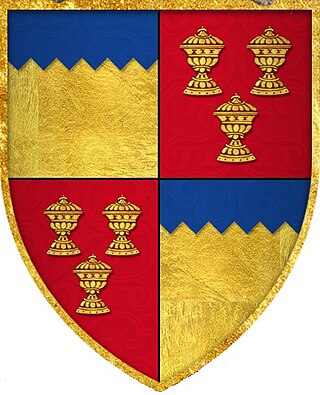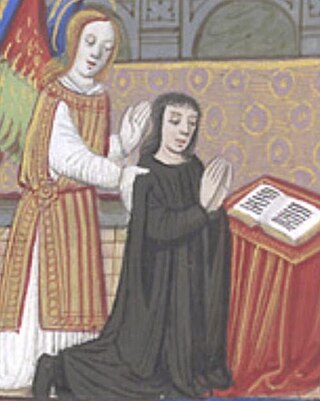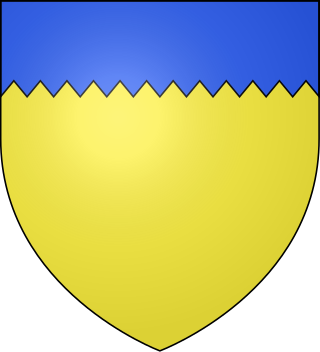Related Research Articles
Walter Butler may refer to:

Piers Butler, 8th Earl of Ormond, 1st Earl of Ossory also known as Red Piers, was from the Polestown branch of the Butler family of Ireland. In the succession crisis at the death of Thomas Butler, 7th Earl of Ormond he succeeded to the earldom as heir male, but lost the title in 1528 to Thomas Boleyn. He regained it after Boleyn's death in 1538.
Sir Walter Butler, 11th Earl of Ormond and 4th Earl of Ossory (1559–1633), succeeded his uncle Black Tom, the 10th earl, in 1614. He was called "Walter of the Beads" because he was a devout Catholic, whereas his uncle had been a Protestant. King James I intervened and awarded most of the inheritance to his uncle's Protestant daughter Elizabeth. Ormond contested the King's decision and was for that insolence detained in the Fleet Prison from 1619 until 1625 when he submitted to the King's ruling. He then found a means to reunite the Ormond estate, by marrying his grandson James, who had been raised a Protestant, to Elizabeth's only daughter.

Thomas Butler, 7th Earl of Ormond PC was the youngest son of James Butler, 4th Earl of Ormond. He was attainted, but restored by Henry VII's first Parliament in November 1485, and the statutes made at Westminster, by Edward IV, which declared him and his brothers traitors, were abrogated.
James Butler, 3rd Earl of Ormond, was a noble in the Peerage of Ireland. He acceded to the title in 1382, and built Gowran Castle three years later in 1385 close to the centre of Gowran, making it his usual residence, whence his common epithet, The Earl of Gowran.
Richard Butler, 1st Viscount Mountgarret was the son of Piers Butler, 8th Earl of Ormond and Lady Margaret Fitzgerald. He married his half first cousin Eleanor Butler, daughter of Theobald Butler of Polestown, the illegitimate brother of the 8th Earl of Ormond. He was created 1st Viscount Mountgarret in 1550.

Earl of Carrick, in the barony of Iffa and Offa East, County Tipperary, is a title in the Peerage of Ireland.
Richard Butler, 3rd Viscount Mountgarret (1578–1651) was the son of Edmund Butler, 2nd Viscount Mountgarret and Grany or Grizzel, daughter of Barnaby Fitzpatrick, 1st Baron Upper Ossory. He is best known for his participation in the Irish Confederate Wars on behalf of the Irish Confederate Catholics.
There have been four baronetcies created for persons with the surname Butler; two in the Baronetage of Ireland and two in the Baronetage of the United Kingdom. As of 2014 two of the creations are extant.
Sir Edmund MacRichard Butler of Polestown was the eldest son of Sir Richard Butler of Polestown and adopted the Gaelic title of The MacRichard of Ossory.
Sir James Butler of Polestown was a warlord in Yorkist Ireland.
Thomas Butler, Viscount Thurles was the son and heir apparent of Walter Butler, 11th Earl of Ormond (1559–1633), whom he predeceased. He lived at the Westgate Castle in Thurles, County Tipperary. He was accused of treason but drowned in a shipwreck off the Skerries in the Irish Sea, before he could be judged. He was the father of the Irish statesman and Royalist commander James Butler, 1st Duke of Ormonde.

Butler is the name of a noble family whose members were, for several centuries, prominent in the administration of the Lordship of Ireland and the Kingdom of Ireland. They rose to their highest prominence as Dukes of Ormonde. The family has produced multiple titles such as Baron Cahir, Baron Dunboyne, Viscount Ikerrin, Viscount Galmoye, Viscount Mountgarret, Viscount Thurles, Earl of Carrick, Earl of Kilkenny, Earl of Ormond, Earl of Ossory, Marquess of Ormonde and Duke of Ormonde. Variant spellings of the name include le Boteler and le Botiller. The Butlers were descendants of Anglo-Norman lords who participated in the Norman invasion of Ireland in the 12th century. The surname has its origins in the hereditary office of "Butler (cup-bearer) of Ireland", originating with Theobald Walter, 1st Chief Butler of Ireland. The arms of later family members depicted three cups in recognition of their original office.
Richard Butler of Kilcash was an Irish soldier and landowner, the third son of Thomas Butler, Viscount Thurles and brother of James, 1st Duke of Ormonde. He sided with the Irish Confederacy at the Irish Rebellion of 1641. He scouted the enemy on the morning of the Battle of Cloughleagh. His descendants succeeded to the earldom of Ormond when the senior branch of the family failed in 1758.
Walter Butler of Ballinakill Castle, Roscrea was a military officer, who served as a colonel (Oberst) in the Imperial Army under Albrecht von Wallenstein and was involved in Wallenstein's assassination in 1634.
Peter Butler of Roscrea, County Tipperary, was a descendant of the Butler family - the Earls of Ormond. He was the second son of Edmond Butler of Polestown. The "Roscrea" cadet branch of the family is in turn descended from the "Polestown" cadet branch.
Sir Richard Butler of Poletown, County Kilkenny, was a descendant of the Butler family - the Earls of Ormond. He was the third son of Edmond Butler of Polestown. He was invested as a Knight on 21 April 1605. His older brother Peter founded the "Roscrea" cadet branch of the family, which is in turn descended from the "Polestown" cadet branch.
Edmond Butler of Polestown,, was a descendant of the Butler family - the Earls of Ormond. He was the eldest son of Walter Butler of Poletown. His brothers were Richard, Peter and Walter. His uncle Peter founded the "Roscrea" cadet branch of the family, which is in turn descended from the "Polestown" cadet branch. He held the office of Member of Parliament (M.P.) for County Kilkenny from 1634 to 1635.
The High Sheriff of County Kilkenny was the British Crown's judicial representative in County Kilkenny, Ireland from the 16th century until 1922, when the office was abolished in the new Free State and replaced by the office of Kilkenny County Sheriff. The sheriff had judicial, electoral, ceremonial and administrative functions and executed High Court Writs. In 1908, an Order in Council made the Lord-Lieutenant the Sovereign's prime representative in a county and reduced the High Sheriff's precedence. However, the sheriff retained his responsibilities for the preservation of law and order in the county. The usual procedure for appointing the sheriff from 1660 onwards was that three persons were nominated at the beginning of each year from the county and the Lord Lieutenant then appointed his choice as High Sheriff for the remainder of the year. Often the other nominees were appointed as under-sheriffs. Sometimes a sheriff did not fulfil his entire term through death or other event and another sheriff was then appointed for the remainder of the year. The dates given hereunder are the dates of appointment. All addresses are in County Kilkenny unless stated otherwise.

Clogrennane Castle is a ruined castle in County Carlow, Ireland, near Clogrennane, about two miles from Carlow on the River Barrow on the county border with County Laois.
References
- ↑ George Edward Cokayne, editor, The Complete Baronetage, 5 volumes (no date (c. 1900); reprint, Gloucester, U.K.: Alan Sutton Publishing, 1983), volume III, page 268.